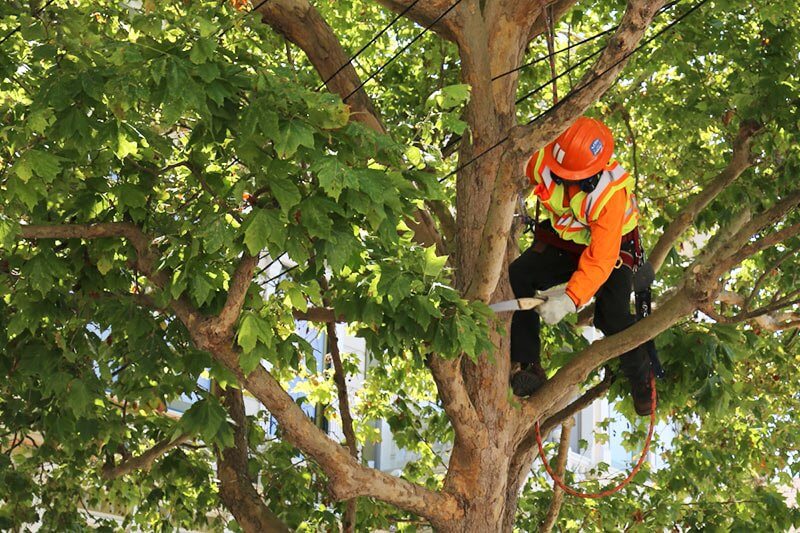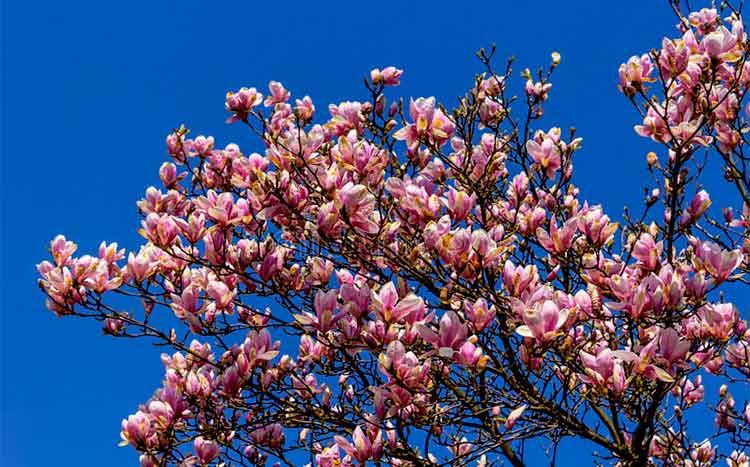Pruning is an excellent method for improving the wellbeing and aesthetics of a Magnolia tree. Numerous specialists recommend using sharp loppers or hand-pruning shears for the early stages of trimming. Typically, the initial cuts involve removing brittle or impaired branches. This entails the elimination of all fractured, deceased, or infected limbs.
Limbs that do not align with the tree’s natural and intended shape are normally next in line. Pruning professionals then remove suckers and crisscrossing limbs. The best way to prune magnolia trees is to cut the limbs off beyond the branch collar.
It is also advisable to only prune magnolia trees to a maximum limit of one-third each season. This aids them in achieving optimum growth and nutrition. A mature magnolia tree should however not be trimmed unless it is completely necessary.

What we cover
ToggleCost of trimming magnolias
| Size | Low | High | |
|---|---|---|---|
| Small Young Trees | Up to 30 Feet | $75 | $450 |
| Medium | 30 feet to 60 Feet | $150 | $875 |
| Large Mature Trees | 60 feet and above | $200 | $1000 |
How to trim a magnolia tree?
Magnolia trimming tips
Prioritize Dead and Diseased Branches
Since you can only prune a magnolia tree up to 1/3 of its size, you should prioritize pruning dead and sick branches before cutting out the healthy but unattractive ones. Dead limbs are usually identified by their brittle, decolorized, and unproductive nature.
This remains constant even during the early spring blooming season. They should thus be pruned 1 inch away from the trunk using disinfected lopping shears. Sick branches are also easily recognizable through discolored foliage, a rotting bark, mildew infestation, and sagging.
Ensure the Season is Right
Magnolia trees often experience their first bloom between early spring and the end of summer. This is usually their recommended pruning time. This is because trimming at any other time usually interferes with their extent of blossoming during the next season.
Choose your Branches According to your Trimming Purpose
Magnolia trimming is done for risk management and growth control. Dead, dying, infected, and weak limbs are pruned first to reduce the risk of disease and death. Small branches on the lower part of the trunk are then pruned to prevent any excessive growth.
Prune Magnolia Trees Safely
Safety for the tree involves ensuring the tree is not left in a vulnerable state because of the pruning techniques applied. Branches should thus be trimmed off beyond the collar to prevent any bark damage that may cause trunk infections.
Pruning of Magnolia trees1 should also only be done lightly to help the trees produce more blooms in future seasons. Water sprouts which usually grow in areas where branches are cut off should equally be rubbed off.
Dry and sunny atmospheres in late spring and early summer present the best conditions for Magnolia pruning since they help to keep freshly cut wounds free from infection.
The person trimming the magnolia tree should also acquire the necessary gear which includes hand gloves, goggles, loppers, shears, and a ladder to keep himself safe. A professional arborist or tree expert can also be engaged especially if the tree has extensive issues.
You can get three estimates from local tree service professionals in a matter of two minutes. Kindly follow the steps below to enjoy this great service:
- Scroll to the top of the page and enter your zip code
- Answer questions about your tree service job
- Your tree service details are forwarded to three local experts who will send you a price estimate for your job with some friendly advice
Differences Between Evergreen and Deciduous Magnolias?
| Deciduous Magnolias | Evergreen Magnolias |
|---|---|
| Shed their leaves in Winter | Retain their leaves in Winter |
| Best planted in Autumn | Best planted in Spring |
| Can thrive in colder climates | Thrive only in warmer climates |
| Grow faster and larger | Grow slower and smaller |
| Harder to maintain | Easier to maintain |
| Require more soil fertility | Require less soil fertility |
Trimming Deciduous and Evergreen Magnolias
Deciduous Magnolia Trees
Pruning deciduous magnolia trees usually begins by trimming off all weak, damaged, and improperly growing branches. These branches are usually cut 1/4-inch beyond a healthy bud node just moments after planting using either a pair of loppers or shears.
Any more pruning whether for shaping or health purposes should be done between mid-summer and early fall. You should cut branches back to a natural fork either using lopping shears for smaller, lower branches or a trimming saw for larger boughs.
Hand pruners can also be used to flush cut all suckers and waterspouts which may appear on the ground, trunk, and larger boughs. Deciduous Magnolias should also be annually inspected for proper shape and size.
Evergreen Magnolia Trees
Evergreen Magnolias are first trimmed at planting time. This is usually done to do away with excessively long branches which interfere with the trees’ intended shape and growth pattern. It is harder to identify deadwood on an evergreen tree than on a deciduous one.
This is because evergreens are usually trimmed off in early spring. Dead branches can however be identified by scraping through the barks of suspected limbs using a sharp knife. Green material underneath is an indication of life while grey or brown tissues signify death.
Branches should be trimmed off back to a natural fork to maintain the tree’s overall shape. Flush cutting can also be done for any suckers or waterspouts. Evergreen magnolia pruning should be done at least once every 3 years.
When should magnolia trees be trimmed?
Evergreens are best trimmed in late spring. Midsummer and early fall pruning is however recommended for deciduous magnolias.
FAQ's
Dormant seasons are regarded as the best times to trim Star Magnolias. This is because such seasons make it easier to distinguish between a bud and a mature flower. Lower branches that do not receive enough light to flourish should be trimmed off first.
The trimming of old blooms should be done without interfering with the growing points located under the blossoms. This enables them to be preserved for fresh blooming in future seasons.
Southern Magnolias seldom require trimming. They can however be trimmed in cases where a broken or stray limb is spoiling the intended shape of the tree.
A mature saucer magnolia tree averages a height of 25 feet.

- The Magnolia Company, (2022) A Guide on When and How to Prune Magnolia Trees. <https://www.themagnoliacompany.com/blog/magnolia-tree-pruning-guide/> Accessed: 01-03-2024.













